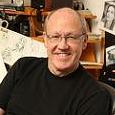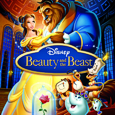Walt Disney Productions (November 13, 1991), Walt Disney Home Entertainment (October 8, 2002), 2 disc set, 90 mins plus supplements, 1.85:1 anamorphic widescreen ratio, Dolby Digital 5.1 Surround, Rated G, Retail: $29.99
Storyboard:
Beauty And The Beast starts out with a storybook-like introduction that uses stained-glass windows to tell the story of the beast. In the story, a young, selfish prince is visited by an ugly woman who offers him a rose in return for shelter. When he casts her away, she turns into an enchantress who curses him to live the life of a beast until he can learn to love another and earn their love in return. He must doe this before the last petal falls on the rose she gives him, or else he will have to live his life as a beast forever. This is when the movie cuts to Belle (voiced by the incredibly talented Paige O’Hara), a beautiful, young, woman who lives in a small village in provincial France. Through the brilliant opening number, with the song entitled “Belle”, it becomes evident that Belle is a misfit in her little town. Her main interest lies in reading books, and the one person she loves is her father, Maurice, who is an inventor. Also in the town is the young and handsome Gaston (the deep-voiced Richard White) who has his eyes set on marrying Belle, despite her polite rejections.

The next morning, her father is off to the county fair to present his latest invention. On his way, he gets lost in the forest, is attacked by wolves, loses his horse, and stumbles upon a creepy-looking castle. Inside, he is treated as a guest by strange, talking household objects, including a candelabrum named Lumiere (Jerry Orbach), a clock named Cogsworth (David Ogden Stiers), a pot named Mrs. Potts (Angela Lansbury), and a cup named Chip (Bradley Pierce). Suddenly, the master of the castle, a hideous beast (Robby Benson), comes out and throws the man into the dungeon. Back home, Belle suspects something is wrong with her father when his horse returns. She follows the horse to the enchanted castle and wanders inside to find her father trapped in the dungeon. She makes a plea to the beast to let her take her father’s place in the dungeon and the beast agrees. Knowing that this girl could be the one to break the spell, the beast tries to force her to fall in love with him, with the help of his servants. Their relationship evolves through a series of events that forces them to trust one another and realize that there just might be something between them they had not noticed before.
The Sweatbox Review:
I can still remember going to the theatres to watch Beauty And The Beast back in 1991. I was eight years old at the time and going to the movie theatres was a rare treat. I can still remember the fresh popcorn that I had, and of enjoying the moment with my dad, but what I most vividly remember is the anticipation for what I was about to see. After the movie was over, I concluded that it was the best movie I had ever seen. This feeling would linger later when I urged my parents to buy me the video once it came out. I remember the numerous hours my sister and I spent in front of the television singing along with the characters, and trying to write down and make sense of every word they were singing. Now, nearly a decade later, the same feeling of anticipation has returned. Watching the DVD for one of my all-time favorite movies was an experience where I had to contain myself from speaking or singing along with every line.
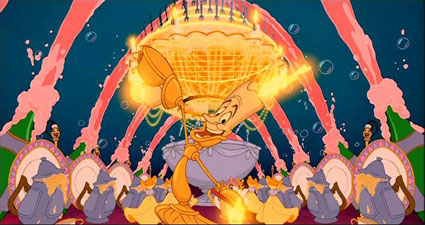
With the critical and financial success of The Little Mermaid, the kind of success Disney had not seen in a long time, fueled a new era in animation history. Howard Ashman, who had received writing credits for The Little Mermaid, was welcomed back to help produce another musical. Together with directors Gary Trousdale and Kirk Wise, and with the collaboration of screenwriter Linda Woolverton, composer Alan Menken, and producer Don Hahn they were set on making a new musical based on the story of Beauty And The Beast.
The story of Beauty And The Beast has its most popular origins in the eighteenth century novel by Madame de Beaumont. Walt Disney and his story department had already attempted to develop a movie based on the story in the 1930s and again in the 1950s before shelving the story indefinitely. With the renewed public interest in fairy tales, proved in part by the success of The Little Mermaid, the story returned to the production table in 1989. However, there were several problems with the first draft, and the story department had to start from scratch once again. Somehow, Disney’s very capable story team got together and came up with a brilliant version of the classical tale. Teamed with Ashman and Menken, who brilliantly managed to put the story into song, they managed to come up with a way to make the story work with songs driving the characters. In an unprecedented move, Katzenberg hired professional screenwriter Linda Woolverton (who would also pen The Lion King) to develop the story further with the rest of the story team. Soon after, work on the film began in Disney’s Burbank studios.
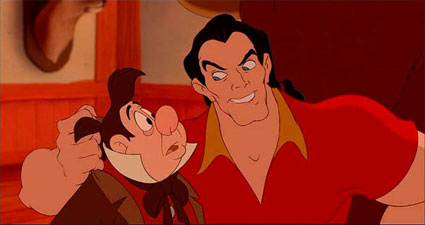
After two years of hard work, and with a rapidly approaching deadline, the filmmakers were presented with the opportunity of showing their “work in progress” version at the New York Film Festival. Although Disney had previously shown their work in this format to members of the press, they had never shown one at such a prestigious film festival. They were quickly met with critical praise and Beauty And The Beast became one of the most anticipated animated features of the year. It debuted on November 13, 1991 and went on to gross over $145 million at the domestic box office, and another $200 internationally. Beauty And The Beast became a landmark film for breaking the notion that animated films were only for kids. It wasn’t just the public embracing the film, but also film critics and people in the industry. Not since the early days of Disney had animation been regarded as legitimate film art. This feeling led the way for the film to win the Golden Globe Award for Best Comedy or Musical and for the film’s unprecedented Best Picture nomination at the Academy Awards, becoming the only animated feature to ever be nominated in such a category.
Much of what makes Beauty And The Beast work is its soundtrack. The collaboration between Howard Ashman and Alan Menken as a song-writing team puts them into the same league as the Sherman brothers. Three of the film’s songs were nominated for the Academy Award for Best Original Song (“Belle”, “Be Our Guest”, and the winner “Beauty And The Beast”). What makes these songs great is that they clearly bring the characters into focus and push the story forward. “Belle” brings our heroine, her relationship with her town, Gaston, and her father into focus. It is a beautiful song that I still have not caught all the words to. “Be Our Guest”, a song originally intended for when Maurice arrives at the castle, is a fun show tune that Lumiere and the others sing for Belle over dinner. “Gaston” is one of my favorite songs and it is another fun song that gives us insight into who Gaston is and what his ambitions are. Finally, “Beauty And The Beast” is the pivotal love song of the movie that plays in the film’s most romantic ballroom sequence. The then-new Celine Dion and Peabo Bryson sang the pop release of this song, which became a radio hit.

The quality of the animation is another key factor that makes Beauty And The Beast work. Some of the best animators of the time, such as James Baxter (now at DreamWorks), Andres Deja, Glen Keane, Will Finn (director of next year’s Home on the Range), and Nik Ranieri have gone on to become directors or have continued animating important characters. Many of the characters went through several phases of design, specially the beast. The beast has been described as part bison, bear, lion, boar, wolf, and gorilla, and Glen Keane spent extra time at the zoo trying to coordinate the movements for his character. While Keane studied gorillas and how they walked, James Baxter studied the movement of ballerinas to create Belle. Other animators like Nik Ranieri and Will Finn had to deal with the movement of inanimate objects such as clocks and candelabras and anthropomorphize them. Even Mrs. Potts was a challenge since she was basically a bouncing head. Quality animation combined with lush, colorful backgrounds created a fantastic environment for the story to take place.
Beauty And The Beast was made in the early days of computer graphics technology. Disney had already begun working with computer as early as The Great Mouse Detective and the technology continued to develop in films such as The Rescuers Down Under. With Beauty And The Beast, the technology was still new and the directors were a bit hesitant in applying it too blatantly. They had considered many sequences where they could use the computer, including the sequences that take place inside the forest. While working on the ballroom sequence, they decided that that sequence would be perfect for the computer treatment. The result is one of the most memorable scenes of the movie. With sweeping camera movements, gorgeous computer-animated backgrounds, and with the beautiful “Beauty And The Beast” song, this sequence has the entire package and makes for a very romantic setting.

In 2001, Beauty And The Beast was re-released on IMAX screens and proved to be another success story for Disney. In the restored IMAX version, which is also available on this disc, they added an extra musical sequence that was cut out from the original film. In this sequence, that would have taken place after Belle and the Beast start falling in love and before the breathtaking ballroom sequence, the household servants band together to clean up the castle in order to provide a romantic atmosphere for the couple. Originally, they did not know how to incorporate the sequence, which included the song called “Human Again”, into the final story. It was only when Beauty And The Beast premiered on Broadway that someone figured out a solution. The song was such a success in the Broadway version that they decided to add it back into the movie for the special edition. They also had to go back and “clean up” the backgrounds of the castle after the sequence since the servants were supposed to have cleaned it all up. For me, I could have done without the sequence back in the film, which I find a little bit over the top, but it is an interesting sequence in that it really puts into perspective what the servants most want.
In the end, Beauty And The Beast is a success because of the collaboration of extremely talented people who shared a single vision. Everything from the writing to the music works together to create a film that will go down in movie history as one of the best animated films of all time. The movie’s central theme that true beauty lies within works on many different conceptual levels throughout the film, from the character design to the voices, that as a viewer I always find new things that I had never noticed before. Because of all of this, it is easy to see why this film can still enchant audiences nearly a decade after its initial release.
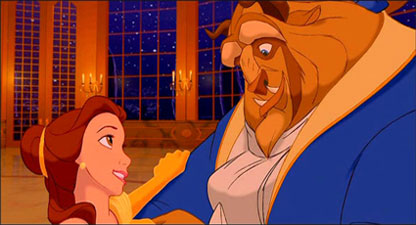
Is This Thing Loaded?
This Platinum Edition, two-disc set comes packed with special features, so let us get started. On the first disc, there are only a few features, but there are three separate versions of the film you can choose from. You can choose the Original Theatrical Version, the Special Edition Version, or the Work In Progress Version. The difference between the original and special edition is the “Human Again” sequence and the “clean-up” of the castle after that same sequence. The Work In Progress version was originally shown at the New York Film Festival in 1991 and it is a mix of storyboard, pencil sketches, and final animation. More than half of Beauty And The Beast had already been finished by the time of the festival, but since a work in progress version was requested, they mixed all of the different types together. Although it is a work in progress version, the animation, especially the final animation, has also been restored.
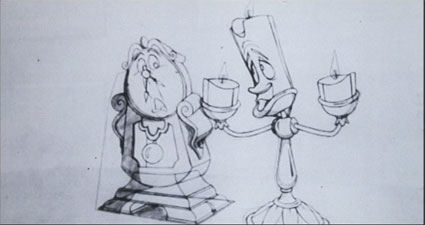
The rest of the disc includes sneak peaks at several future Disney releases. There is a theatrical trailer for The Jungle Book 2, due next year, and for The Lion King IMAX release. There are also previews for the DVD editions of Lilo & Stitch, Beauty And The Beast: The Enchanted Christmas, Sleeping Beauty: Special Edition, and Winnie the Pooh: A Very Merry Pooh Year. There is also a commercial for Walt Disney World. Aside from the sneak peaks, the only other special feature on disc one is “Maurice’s Invention Workshop Game”. The game is just a trivia game where you help Chip piece all of Maurice’s invention pieces together (only pots, candelabras, clock gears, and cups are options standing for the four different characters). The result of the game is the clue to enter the west wing in disc two.
The second disc is where most of the features are. Once you enter the main menu, you are treated with four different options. You can click on the stained-glass window of Lumiere & Cogsworth, Chip, or Mrs. Potts. There is also a large rose at the top for the game, and a mirror at the bottom to see a list of all of the options.
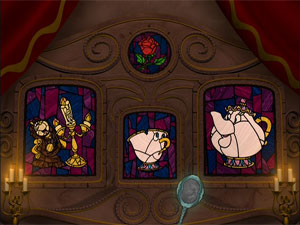
Lumiere and Cogsworth’s section, which takes place in the library, features eleven sections about the different stages of the development of Beauty And The Beast. The first section is entitled “Origins of Beauty And The Beast”, which is followed by “Development”, “Story”, “Music”, “The Characters”, “Production Design”, “Animation”, “Tricks of the Trade”, “Release and Reaction”, “The Broadway Music”, and “The Special Edition”. Each section is part of a longer documentary. You can also select to play them all in order. In this full feature, which lasts about fifty-one minutes, you will find interviews with many of the people involved in the making of Beauty And The Beast. The interviews are recent, but there are many shots from the making of the movie.
There were several features in this section that I did not find at first, since you are eluded into thinking that the “Play All” function actually plays everything. However, this is only partly true. In the “Development” section, you will find an “Early Presentation Reel”. With an introduction by Hahn, this short reel is really just a bunch of early concept picture narrating the movie, set to music. In the “Story” section, you will find an alternate version of the song “Be Our Guest”. The sequence features early pencil sketches of the song with Maurice as the guest instead of Belle. The sequence was changed to Belle later and the lyrics and animation had to be modified in some parts, but much of it is the same. Hahn also introduces the original version of “Human Again” which can be found here with the use of the original demo tape and storyboard sequences. In the “Music” section, you will find an alternate version of the final transformation sequence with a different score and in pencil sketches once again. Alan Menken introduces the sequence, which he calls a more emotional version than the one in the film. In this section, you will also find the same “Human Again” sequence, but with an introduction by Alan Menken.

In the “Characters” section, you will be able to trace the development of all the different characters through early sketches. Selected sketches have audio accompaniment. You will find similar still galleries in the “Production Design”, “Release and Reaction”, and “Broadway Musical” sections. Besides the “Characters” gallery, there are six others called “Concept Art & Design”, “Layouts and Backgrounds”, “Original Release Publicity”, “Large Format Publicity”, “Broadway Musical Publicity”, and “Costume Design.” The navigation through the galleries is easy and informative. There are hundreds of drawings and sketches, and this makes it one of the nicest parts about the DVD.
There are also some other small featurettes and early development footage that were not included in the documentary in these sections. In “Animation”, you will find Hahn narrate a section called “Animation Tests, Roughs, and Clean Ups” where he shows what the early stage of animation looks like and how much work is put into it. There are two segments dedicated to the transformation sequence, which is one of the most memorable moments of the movie. “The Transformation: Pencil Version” is introduced by Hahn and the pencil version of the sequence follows. The second segment is “A Transformation: Glen Keane” where the artist talks about the animation of that sequence and what it meant to him. In “Tricks of the Trade”, you can click on “Camera Move Test” to see camera tests for the ballroom sequence. The “Beauty And The Beast” music video is available in the “Release and Reaction” section. Finally, in the “Release and Reaction” section, you can also select “Trailers & TV Spots” to view another introduction by Don Hahn, a trailer for the original release, another for the large format release, and four television spots.
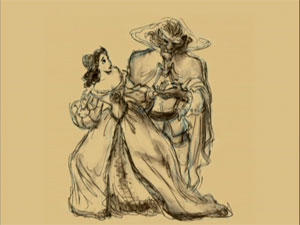
Chip’s section is designed for children and it features mostly material aimed at that audience. There is a “Disney’s Animation Magic” featurette that takes you backstage into the Disney Studio and looks at how cartoons are made. The featurette lasts about fourteen minutes and is an amusing take on the animation process. Also in Chip’s section is “Chip’s Musical Challenge” where you have to remember the sounds of different ‘instruments’ in order. They add one at a time, but I found the game kind of boring, but children might find it amusing. Finally, in Chip’s section is the “Beauty And The Beast” music video performed by the group Jump 5. While they have made the song catchier, overall, I was not impressed with this new music, but, again, this is aimed at pre-teens.
Finally, Mrs. Pott’s section features a few more special features. There is “The Making of Beauty And The Beast” feature, which is hosted by Celine Dion and runs for roughly twenty-six minutes. The making-of feature briefly touches on some of the same aspects as the other making-of featurettes, and it really is just a compressed version of Cogsworth and Lumiere’s section. It includes interviews with the makers, film historians, and other people involved with the movie such as Roy Disney. This feature is more kid-oriented than Lumiere and Cogsworth’s but still interesting. Another feature in Mrs. Pott’s section is a featurette called “The Story Behind the Story”. This includes the origins to many of Disney’s most famous tales including Cinderella, The Lion King, Pocahontas, The Jungle Book, Sleeping Beauty, Mulan, and The Hunchback Of Notre Dame. Celine Dion also hosts this section. Also featured is “Mrs. Pott’s Personality Game” where you can find out which character you are most like from the movie (for me it was Cogsworth). Finally, there is a repeat of the original “Beauty And The Beast” music video performed by Celine Dion and Peabo Bryson. I had three questions running through my mind while browsing this section. What ever happened to Peabo Bryso? Why is Celine Dion the primary pick for hosting all of these features? Were Paige O’Hara, Robbie Benson and the rest of the cast just too busy to make appearances as hosts or were they never asked? Just food for though.
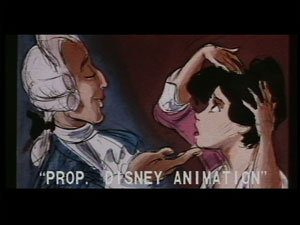
The final feature of the disc is the game that takes place in the west wing. You can access the game by selecting the rose in the main menu. It is a tricky game, and even the getting it started is difficult since you must try getting there twice before you are allowed inside. Inside, you insert the password that Chip gave you on the first disc to continue. The goal of the game is to break the spell and return everyone to their original human form. To do this, you must reach the rose before the storm destroys it. The tasks include recalling information about the movie and making your way through the castle while dodging balls, moving furniture, and candlesticks. I am sure any child can pass this game, but I found the dodging sequences very frustrating and went through several roses (for each error, you lose a petal) before finishing the game. This is partly due to the fact that some of the directions you have do not make sense, and partly because I am out of practice with these types of games. If you do not want to know what happens in the end, skip to the next paragraph now. In the end, there is no reward and all you get is congratulation from Chip.
Case Study:
The packaging is different from the previous Snow White Platinum Edition, with a cardboard slip with a foldout cover, and a black, two-disc Amaray case like the one used in the Monsters, Inc two-disc set. One marking that puzzled others and me is the “I” on the spine of the DVD. Some have argued that this “I” means it is the first in the Platinum Edition series, but that clearly was Snow White and the Seven Dwarfs. Others have reluctantly said that this “I” means it is the first disc in the Beauty And The Beast collection and that The Enchanted Christmas should have a “II”. Whichever the case is, I hope we find out very soon.
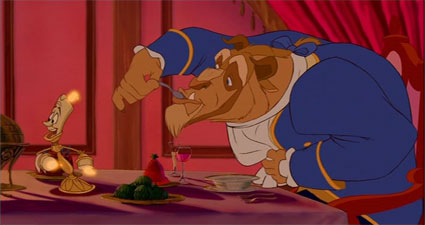
Ink And Paint:
The movie is presented in the 1.85:1 anamorphic widescreen aspect ratio. This has brought confusion to many who own the laserdisc version, which has the original 1.66:1 aspect ratio. As mentioned, there are three version of the movie available here – the “original”, the “special edition” and the “work in progress” versions already mentioned. I have been told that both “original” and “special edition” versions have actually trimmed a little off the top and bottom to give it the new ratio. I think this version is actually restored from the IMAX release, which was in turn restored from the original release. This is unfortunate, as it seems that the truly original version may never be released again. Having said that, this restored version is spotless. The colors of the animation and backgrounds are vibrant, and the work done to restore them is impressive. It is a great transfer all around.

Scratch Tracks:
The sound for this edition has also been restored. It boasts a new THX-certified Dolby Digital 5.1 Surround Sound track. The music sounds better than ever and the restoration is a success. The audio does not, however, take full advantage of the surround feature, but still manages to impress the audience. There is also a commentary track for the special edition with producer Don Hahn, and directors Kirk Wise and Gary Trousdale. Composer Alan Menken also makes an appearance in the commentary. The commentary is very well done and there is plenty of humorous and interesting information about the making of the movie. You will learn many Beauty And The Beast trivia question and answers just by watching it, such as the signs at the crossroads in the forest. A French track is also available for the film. English captions, as well as sing-along captions are also available.
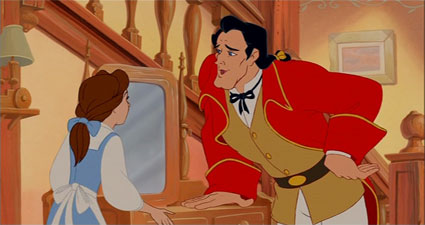
Final Cut:
This is a very comprehensive, and, to use a word from the package, “experiential” DVD. Disney has once again proven that they can deliver an impressive collectors edition. As a follow-up to Snow White and the Seven Dwarfs: Platinum Edition, this DVD lets us know what to look forward to in all of the next Platinum Editions. This disc is for both old and new fans of this classic Disney tale. The story is charming, the animation breathtaking, and the musical score extremely memorable. This is a must-have edition for any animation collector.
 | ||
 |






